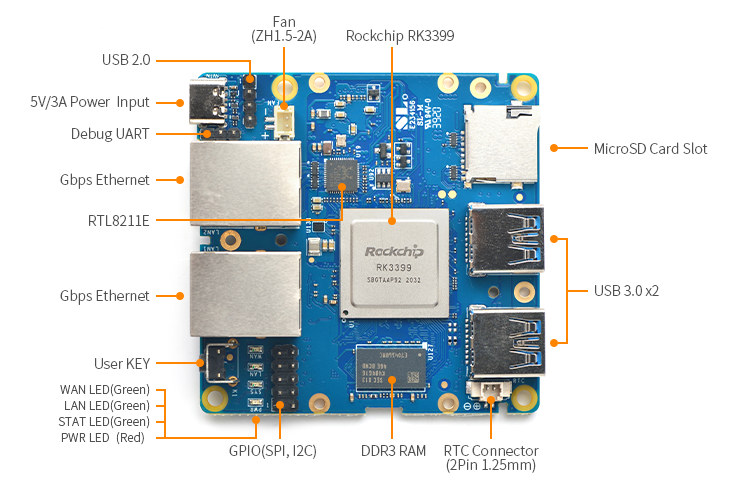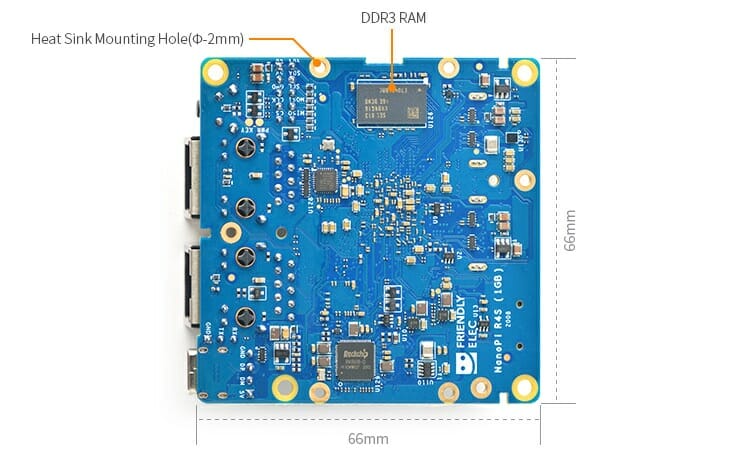We’ve seen several tiny ultra-cheap boards for headless applications over the last few years with products Orange Pi Zero Plus or NanoPi R2S which are usually based on 32-bit Cortex-A7 or low power 64-bit Cortex-A53 processors, coupled with up to 512MB to 2GB, and may have some limitations when it comes to Gigabit Ethernet and USB 3.0 speeds.
If you’d like something similar but more powerful, FriendlyELEC is working on NanoPi R4S headless SBC powered by a Rockchip RK3399 hexa-core Cortex-A72/A53 processor with up to 4GB RAM, dual Gigabit Ethernet, and two USB 3.0 ports.
 NanoPi R4S preliminary specifications:
NanoPi R4S preliminary specifications:
- SoC – Rockchip RK3399 hexa-core processor with dual-Core Cortex-A72 up to 2.0GHz, quad-core Cortex-A53 up to 1.5GHz, Mali-T864 GPU with OpenGL ES1.1/2.0/3.0/3.1, OpenCL, DX11, and AFBC support, 4K VP9 and 4K 10-bit H265/H264 60fps video decoder
- System Memory – 1GB DDR3 or 4GB LPDDR4
- Storage – MicroSD card slot
- Networking – 2x GbE, including one native Gigabit Ethernet, and one PCIe Gigabit Ethernet
- USB – 2x USB 3.0 Type-A ports, USB 2.0 via 4-pin header
- Expansion – 2×5-pin header with 1x SPI, 1x I2C
- Debugging – 3-pin debug UART header
- Misc- 1x power LED, and 3x user LEDs (SYS, LAN, WAN), user button, 2-pin RTC battery connector, 5V fan connector
- Power Supply
- 5V/3A via USB-C connector or pin header
- RK808-D PMIC and independent DC/DC enabling DVFS, software power-down, RTC wake-up, system sleep mode
- Dimensions – 66 x 66 mm (8-layer PCB)
- Temperature Range – -20°C to 70°C
 Note the specifications are preliminary as the information is not available on the main page of the Wiki, and I just found the board on a “hidden” page where you’ll also find the schematics and CAD files for both the 1GB and 4GB RAM. There will be a heatsink cover most of the top side of the board not already used by connectors and headers. I’m not sure why the company did not place the Rockchip RK3399 processor on the bottom of the PCB as they did with NanoPi M4 since it allows for a larger heatsink and better heat dissipation.
Note the specifications are preliminary as the information is not available on the main page of the Wiki, and I just found the board on a “hidden” page where you’ll also find the schematics and CAD files for both the 1GB and 4GB RAM. There will be a heatsink cover most of the top side of the board not already used by connectors and headers. I’m not sure why the company did not place the Rockchip RK3399 processor on the bottom of the PCB as they did with NanoPi M4 since it allows for a larger heatsink and better heat dissipation.
There’s no information about software, but based on past RK3399 products, FriendlyELEC should offer both Ubuntu and OpenWrt images, and typical use case would be routers, networked storage, IoT gateways, etc…
There’s no price information for NanoPi R4S headless SBC, but considering the $50 price tag for the aforementioned NanoPi M4 SBC and features, around $30-$35 for the 1GB RAM version, and $60-$65 for the 4GB RAM model might be in the right ballpark.

Jean-Luc started CNX Software in 2010 as a part-time endeavor, before quitting his job as a software engineering manager, and starting to write daily news, and reviews full time later in 2011.
Support CNX Software! Donate via cryptocurrencies, become a Patron on Patreon, or purchase goods on Amazon or Aliexpress. We also use affiliate links in articles to earn commissions if you make a purchase after clicking on those links.





Interesting. A long time ago I needed small and powerful dual-port boxes to serve as on-wire packet capture devices or emergency firewalls. I don’t need that anymore but such a device could perfectly fit. Right now the closest I have is my clearfog, which I manage to power from USB using a USB-to-12V adapter.
I suspect the reason for placing the RK3399 on the “wrong side” is that the ethernet ports are very high and leave a big hole behind, that can easily fit a heat sink. I still prefer to have the heat sink at the bottom for compute devices (like my Neo4 and M4). But when you need to place the board into a tiny plastic box, there’s possibly less room for a big heat sink at the bottom than at the top. However with the chip at the bottom, it’s possible to use a metal enclosure to serve as a huge heat sink.
Very interesting. I’ve long been looking for the “perfect red team drop box”, and this is so close!
Unanswered questions so far: from the RK3399 datasheet, it appears that the chip supports up to 4 USB2.0 ports. 2 are used in the USB3.0 connectors, one is available on a header. Is the fourth wired up to the USB-C port, to act as a USB device? If it is, that would be amazing!
WiFi can be added with a nano-dongle (or bigger if size is not a constraint). It will be interesting to see just how much power it really demands, with no external accessories, doing tasks such as packet forwarding, etc.
Would be really funny to use this as an embedded password cracking box, with the OpenCL capability.
According to the schematic from the wiki, sadly the USB-C is power only and the remaining USB2.0 (host only) is not connected at all.
Only the USB3.0 of the RK3399 are capable of OTG.
Unfortunately, there is no wifi or EMMC.
Sadly, that’s something really annoying with the vast majority of headless SBCs like this, there’s no access to a console once the box is closed. If you lose the IP address, you need to have a screwdriver. The only exception I know to this is the clearfog, which provides a USB console (and some of the SBCs which expose OTG can use usb_gadget to expose a dummy console, which is not as powerful but better than nothing). We really need to see progress in this area, I don’t count the number of times I had to write a known working IP address on a sticker placed on the device 🙁
There is also ESPRESSObin with usb-uart console. With also a Marvel CPU.
Actually it’s probably among Marvell’s design rules to always provide an external access to the console, as even the shevaplug/guruplug had a small connector with the TTL signals, and the mirabox featured a mini-USB port already. You have it on ESPRESSObin, MACCHIATObin, clearfog, etc. This seems essential to me. And I never fear hacking on my mcbin thanks to this.
Damn, I was really hopeful! Such a disappointment!
NanoPI R4S could be used for active monitoring the network edge nodes (see IxProbe from KeySight/Ixia).
Why not attach a 2.5G ethernet? Or better to have 2x 1G ethernet?
From the article:
I think the question was likely: “Why use a Gigabit PCIe controller, and not a 2.5 GbE PCIe controller?”
Exactly!
Isn’t the reason rather obvious? For the type of application (router/firewall) a 2.5GbE port would always be bottlenecked by the other 1GbE port. Increasing BOM costs for no reason.
And adding more than one additional PCIe connected NIC would require either a PCIe switch or special NIC controllers like those for example. Both would end up with higher BOM costs and consumption.
I too looked for dual-port NIC controllers and still couldn’t find any supporting 2.5G.
If you had 2.5GigE, you could connect it to a managed switch and expand the number of networks using vlans
It’s very difficult to plug two cables into a single 2.5G port 🙂
I run my home router on the R2S. Ubuntu and the other distributions have issues with the interface drivers (keeps freezing on reboot for me) so I’ve just been using their friendlyelec port but its a fabulous little thing for home routers. I wrote a short HowItWentForMe on reddit.
Link?
Yet another RK3399 board? Any update on when will Rockchip release its next SOC, the RK3588? Then we might actually see some interesting new SBCs, other than raspberry pi.
How about an IOT version: WiFi, no Ethernet, and dual CSI raspberry PI camera compatible.
In short, nothing in common with this one ? The challenge this one addresses is to have two gigabit ports on the small board. Remove that constraint and you have plenty of other choices.
Could you put two gigabit ports on a S905X3, one using the PCI muxed USB 3 ?
Logically you could, but you’d lose USB3. If that’s not an issue, of course, fine!
this may be the perfect “under $100” pfsense replacement I’ve been looking for
I thought the same but also I thought pfsense doesnt work well, or at all, on non Intel SoCs and NICs.
I would LOVE IT if I was wrong about this.
Previous board R2S has a serious overheating problem. And it’s the only board on rk3328 with such problem. You get 60C on idle, it’s almost unusable without metal case and cooler.
RK3399 is hotter than 3328 so R4S will start to throttle few seconds after boot.
Stay away.
The other RK3328 board that suffers from the same thermal problem is NanoPi NEO3. This is not a SoC but a board problem.
Whatever FriendlyELEC did wrong with their RK3328 implementations does not apply to their much older RK3399 boards: Both NanoPi NEO4 and M4 show thermal behavior that is to be expected: https://github.com/ThomasKaiser/Knowledge/blob/master/articles/Heatsink_Efficiency.md
Agreed, all of my 5 Neo4 and the M4 have been running fine and cool since I assembled them. Not even a single crash or hang despite torturing them from time to time with distributed builds. Their uptime dates from my last UPS death 4 months ago 🙂
According to the schematic the PCI Ethernet used is the Realtek RTL8111H.
> I’m not sure why the company did not place the Rockchip RK3399 processor on the bottom of the PCB
Looks like they prepare the board for a variant of their M3 fansink: https://www.friendlyarm.com/image/catalog/description/M3-heat-sink_en_08.jpg
I too wonder why the SoC is on the wrong PCB side. On the bottom side combined with a nice metal enclosure that acts as large heatsink the whole thing could’ve been cooled passively.
As I mentioned, I suspect they target plastic enclosures and want to make them thinner. However, some plastics have reasonably good thermal conductivity, and I still think that having a large flat metal plate glued to the bottom of the enclosure will spread heat better than an inner heat sink with little to no air flow.
> I suspect they target plastic enclosures
Fortunately we’ve been both wrong but the metal case adds 14 bucks to the bill:
https://www.friendlyarm.com/image/catalog/description/R4S_en_11.jpg
Finally, PCIe instead USB for the second Ethernet interface! True, having the SoC on the other side of the board would have been better, but that’s not a deal breaker for me. Hopefully it will be available before end of the year.
I’d probably buy this as a OpenWRT router if it’s able to shape a gigabit connection. I have an R2S currently which only manages about ~700mbps with SQM enabled. For now, virtualised x86 router on Hyper-V…
Now launched and on sale $45
https://www.cnx-software.com/2020/12/01/buy-nanopi-r4s-sbc-optional-metal-case/